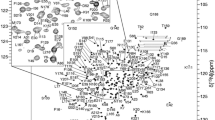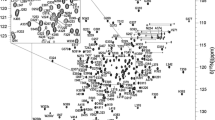Abstract
The μ-toxin of Clostridium perfringens, termed CpGH84A, is modular hydrolytic enzyme that contributes to the pathogenicity of this organism. Backbone and side chain 1H, 13C, and 15N resonance assignments have been determined for the C-terminal 15.5 kDa FIVAR-Doc modular pair of CpGH84A.

Similar content being viewed by others
References
Adams JJ, Pal G, Jia Z et al (2006) Mechanism of bacterial cell-surface attachment revealed by the structure of cellulosomal type II cohesin-dockerin complex. Proc Natl Acad Sci USA 103:305–310
Bayer EA, Belaich JP, Shoham Y et al (2004). The cellulosomes: multienzyme machines for degradation of plant cell wall polysaccharides. Annu Rev Microbiol 58:521–554
Canard B, Garnier T, Saint-Joanis B et al (1994) Molecular genetic analysis of the nagH gene encoding a hyaluronidase of Clostridium perfringens. Mol Gen Genet 243:215–224
Carvalho AL, Dias FM, Prates JA et al (2003) Cellulosome assembly revealed by the crystal structure of the cohesin-dockerin complex. Proc Natl Acad Sci USA 100:13809–13814
Delaglio F, Grzesiek S, Vuister GW et al (1995) NMRPipe: a multidimensional spectral processing system based on UNIX pipes. J Biomol NMR 6:277–293
Ficko-Blean E, Boraston AB (2006) The interaction of carbohydrate-binding module from a Clostridium perfringens N-acetyl-beta-hexosaminidase with its carbohydrate receptor. J Biol Chem 281:37748–37757
Johnson BA (2004) Using NMRView to visualize and analyze the NMR spectra of macromolecules. Methods Mol Biol 278:313–352
Petit L, Gibert M, Popoff MR (1999) Clostridium perfringens: toxinotype and genotype. Trends Microbiol 7:104–110
Rood JI, Cole ST (1991) Molecular genetics and pathogenesis of Clostridium perfringens. Microbiol Rev 55:621–648
Shimizu T, Ohtani K, Hirakawa H et al (2002) Complete genome sequence of Clostridium perfringens, an anaerobic flesh-eater. Proc Natl Acad Sci USA 99:996–1001
Acknowledgements
We acknowledge Dr. Tara Sprules for data collection on the 800 MHz spectrometer and technical support at the Québec/Eastern Canada High Field NMR Facility. This work was supported by a CIHR operating grant to S.P.S. (MOP-77776). S.C. is the recipient of a Franklin Bracken doctoral scholarship. J.J.A. is supported by a NSERC doctoral award. S.P.S. is a Canadian Institutes of Health Research New Investigator.
Author information
Authors and Affiliations
Corresponding author
Rights and permissions
About this article
Cite this article
Chitayat, S., Adams, J.J. & Smith, S.P. NMR assignment of backbone and side chain resonances for a dockerin-containing C-terminal fragment of the putative μ-toxin from Clostridium perfringens . Biomol NMR Assign 1, 13–15 (2007). https://doi.org/10.1007/s12104-007-9002-7
Accepted:
Published:
Issue Date:
DOI: https://doi.org/10.1007/s12104-007-9002-7




